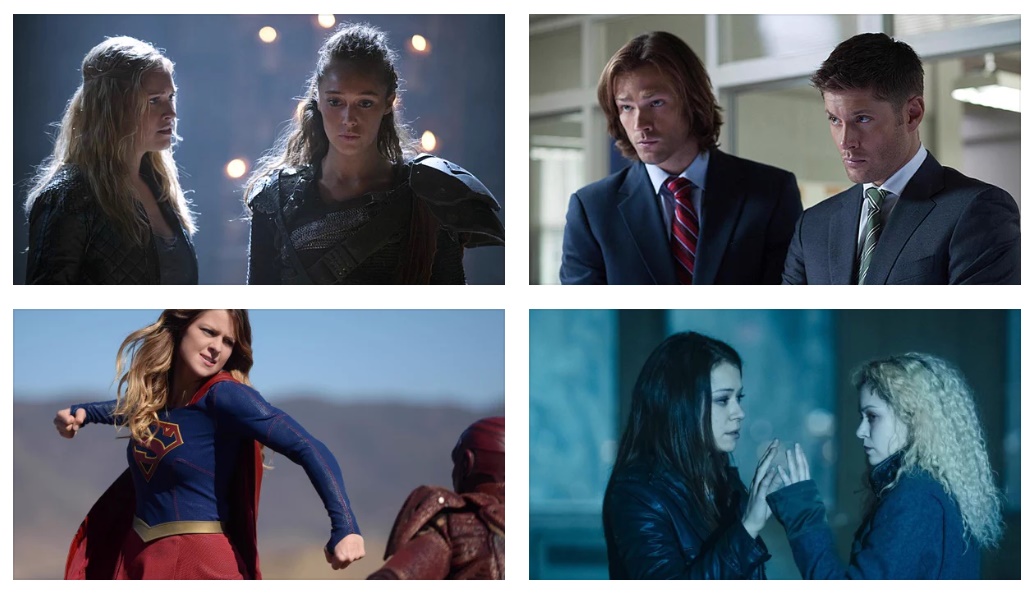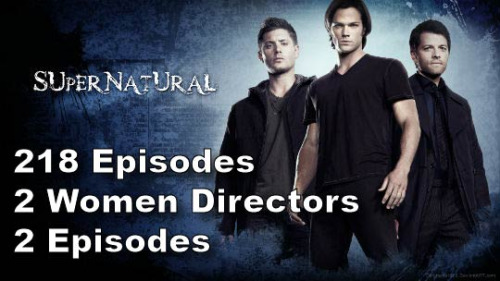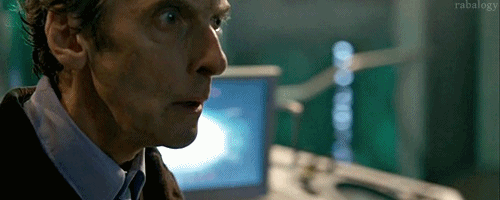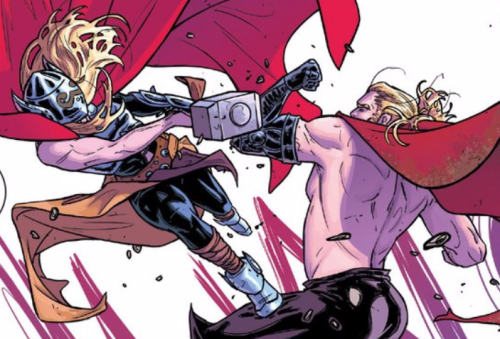This guest post written by Alyssa Franke appears as part of our theme week on Women Directors.
In the battle to address the staggering gender gap in women directing for film and television, there is one huge untapped resource — the passion and organizing power of fangirls.
We all know the depressing statistics, we’ve seen the ACLU letter requesting an investigation into the gender biases in Hollywood’s hiring practices, and we’ve read the horrifying first-hand accounts of sexism and harassment. A long-term solution to the gender gap will probably require a combination of legal action and industry initiatives.
But fan activism can also play an important — even crucial — role. Fans can, of course, raise awareness of the problem within their communities. But even more importantly, fans have the ability to transform complex, industry-wide issues where responsibility can be hard to pin down into personalized campaigns where individuals who contribute to the problem can be held accountable.
You can see similar organizing happening already in fan communities, though these have largely focused on on-screen representation rather than behind-the-scenes representation. When studios have hired white actors to portray characters of color, Racebending has organized fan communities to protest the deliberate exclusion of actors of color and the whitewashing of beloved characters. Fans of Supernatural have confronted the writers of the show at conventions to hold them accountable for fridging nearly every female character on the show. And after a beloved lesbian character was killed on The 100 in yet another example of the “Bury Your Guys” trope, fans organized behind the hashtag #LGBTFansDeserveBetter to support LGBT fans, raise money for charity, and hold the creators accountable. The backlash grew so strong that showrunner Jason Rothenberg eventually apologized for the way the character was killed.
Whitewashing characters of color, fridging women, and sensationally killing off LGBT characters are problems which span the entire movie and television industry. But when fans had a specific instance of each of these problems to latch on to, they could begin to organize movements for change. In each case, fans raised the profile of the broader issue and were able to hold specific individuals accountable for contributing to those problems.
The same principles can apply when it comes to organizing fans to tackle the gap in women directors. When so many people have a hand in hiring directors, it is easy for everyone to shift blame onto someone else. Agents, networks, studios, producers, showrunners, and even actors are able to point fingers at each other and say that someone else is more responsible for the lack of women directors than they are. But as fans begin to notice the gender gap in their own fandoms, they can begin to hold specific individuals, studios, and networks accountable.
But first, fans need to be aware of how the gender gap impacts their own fandoms. After the Equal Employment Opportunity Commission (EEOC) began investigating the systemic discrimination against women directors in Hollywood, I started looking into how many women were directing my favorite TV shows. In October, I posted a series of graphics on Tumblr highlighting some of the most surprising results I had found.
The numbers were seriously depressing. Supernatural, with over two hundred episodes and one of the largest online fanbases, had only hired two women to direct an episode each (they’ve since hired one additional woman to direct one episode). Newer shows like Daredevil and Agent Carter had no women directors (and each show has only hired one woman director since my original piece was published). There were a few shows that had a smattering of women directors here and there, but there were often whole seasons without a single woman directing an episode.
Over twelve thousand notes later, fans are still sharing that post and adding on the number of women who have directed their favorite TV shows. American Horror Story, 0 women directors after sixty-three episodes. Hannibal, 0 women directors after thirty-nine episodes. Orphan Black, one woman directing only two of thirty episodes.
Even shows that are doing better than average are still depressingly below parity. Supergirl has had three women direct three of eighteen aired episodes. Jessica Jones had three women direct four of thirteen episodes. And Elementary has had five women direct fifteen of their ninety aired episodes.
Once fans are aware of the gender gap in directors for their favorite TV shows and movie franchises, they can begin organizing. And they are in a particularly unique position to challenge studios, networks, and creators. As television shows and media franchises have recognized the importance of interacting with fandoms for marketing and engagement purposes, they have also created spaces for fans to challenge and question them. And fans have proven to be particularly adept at getting attention for their issues thanks to that access.
Even though it resulted in no tangible changes, or even an acknowledgement from the creators that their narrative choices might have been damaging, Supernatural fans were able to draw awareness to the show’s terrible treatment of its female characters and publicly challenge the writer to justify his choices. And in The 100 fandom, access to the show’s writers on Tumblr and Twitter seems to have sparked genuine conversation between fans and the creators about the industry’s treatment of LGBT characters. This is particularly true of Javier Grillo-Marxuach, who wrote the episode that sparked the controversy and who has since been talking extensively with fans on his Tumblr to explain the process behind creating the episode and to reflect on their concerns.
Fan activism for more women directors could rely on similar tactics. At conventions, fans would be able to raise the profile of the issue in front of actors, writers, and showrunners — and by extension the studios or networks behind the show or movie franchise. And on social media platforms, fans would be able to use their access to creators and official social media accounts to apply pressure to address the gender gap in directors, spark conversation about the issue, and hopefully gain pledges to address the issue.
When I have discussed this issue within my own fandoms, I often receive feedback from other fans that specific shows or movies should not be held accountable for an industry-wide issue. While I agree that one show shouldn’t be made the scapegoat for the broader problem, I do think this argument misses the point that individual franchises should be held accountable for their contribution to the problem. Each franchise — and its related fandoms — should feel invested in attempting to correct the problem where they can. Incremental change is necessary to jumpstart broader changes.
And I am very aware that fan organizing alone cannot solve the gender gap for women directors. However, combined with the threat of legal action and pressure from within the industry, I think it can play a crucial role by keeping attention on the issue and maintaining pressure on key players in the industry. My hope is that our engagement would compliment efforts from within the industry, and that our efforts would be proof that consumers are aware of the gender gap and invested in seeing it addressed.
4am. Fight scene done. #GirlPower #Supergirl pic.twitter.com/3z9TVQepcx
— Lexi Alexander (@Lexialex) December 19, 2015
I write this piece with the explicit aim that it act as both a guide for organizers and a clarion call for fans.
If you are a woman director, or someone within the industry looking to organize around this issue, I encourage you to engage with fan communities. They are passionate, invested in their favorite franchises, and generally committed to improving representation on and off screen. We want to help, and we can be valuable allies.
If you are a fan, then consider this your call to begin advocating for better representation behind the scenes. We talk a lot about how we want our favorite franchises to do better when representing women and their stories, and one of the best ways to do this is to ensure that a diverse group of people are involved with the crafting of those stories.
Look up how many women have been hired to direct your favorite movies and TV shows. Raise awareness in your fandom. Organize around #AskForMore, or make a specific hashtag for your fandom. And at conventions and on Tumblr and Twitter, ask for more women directors. Be respectful, and remember that the person you are talking with may want to help and is possibly being stymied by someone else involved with hiring directors (it is an incredibly convoluted process, with multiple people involved). Instead of making accusations, ask what they are doing or will do to ensure that more women are hired to direct.
As a fangirl, I am deeply invested in not just the stories that my favorite movies and TV shows are telling, but also the environment in which those stories are created. I want the franchises I love to do better by the women working in the industry, and I’m willing to hold them accountable to make it happen.
Alyssa Franke is the author of Whovian Feminism, where she analyzes Doctor Who from a feminist perspective. You can find her on Tumblr and Twitter @WhovianFeminism.















